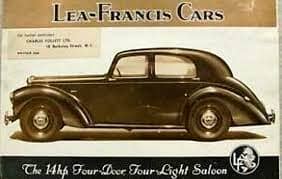LEA-FRANCIS Car PDF Manuals
History of Lea-Francis Cars
There's 1 LEA-FRANCIS car manual PDF above on the page.
Like many British automakers, Lea-Francis has long been involved in the production of bicycles and motorcycles.
After the WW1, she was forced to switch to four-wheeled vehicles.
Throughout the 20s. the company built light sports cars with 4-cylinder Meadows and Anzani engines, which showed good results in races.
In the next decade, an economic crisis hit, and the business went into decline.
The brand got its second chance in 1937 thanks to the new owner George Leak.
Under his leadership, the 12 hp and 14 hp models were developed, which returned to the market in 1946.
At the time, Lea-Francis had a streamlined 4-door sedan, 5-door station wagon and stylish 2+2 roadster in its catalogue, but they were more expensive and slower than the corresponding Jaguar models.
In 1954, the company closed, having produced a total of about 10,000 cars.
In 1976, Barry Price and Peter Engelbach decided to revive the Lea-Francis company and create a new retro car.
They developed a square-section steel tube frame and an aluminum coupe body with a triangular hood, vertical grille, separate fenders and rectangular headlights integrated into them.
The running gear was borrowed from Jaguar, including a 3.4-liter inline 6-cylinder engine and a 4-speed manual transmission.
The prototype was completed in 1980 and the production model, called the Lea-Francis Ace of Spades, went on sale in 1988.
As a result, until 1992, only 5 copies were built in Studley, including one convertible.
Jim Rendle, one of the creators of the Jaguar supercar, in 1998 develops a two-seat roadster for Lea-Francis, designated by the index 30/230.
An aluminum body with double round headlights was mounted on a computer-modeled aluminum platform.
The equipment includes a 3-liter Opel V6 engine with a capacity of 235 hp and active rear suspension.
The car was made in a single copy and is now in the Coventry Transport Museum.


